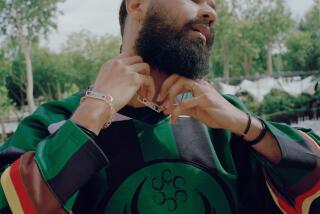Yves Saint Laurent on extravagant display at Paris’ Petit Palais
Reporting from Paris — — To wander through the Yves Saint Laurent retrospective at the Petit Palais in Paris is not just to receive an infusion of fashion history and a privileged peek into the wardrobes of some of the world’s most chic women, although it definitely offers that. It even features a salon set up as the “dressing room” of Saint Laurent muse Catherine Deneuve, with pieces dating from 1967’s “Belle de Jour” to the designer’s 2002 retirement.
But equally impressive is the intimate sense of the man and his artistry one takes away from this extravagant display — nearly three times the size of the 2008 exhibition at San Francisco’s De Young Museum and produced with the patronage of French First Lady Carla Bruni.
On view through Aug. 29, this show — the first in Paris since the designer’s 2008 death — demonstrates the scope of Saint Laurent’s influence on 20th century fashion. In the first gallery alone, spanning the 1960s and early 1970s, there are his signature “le smoking” tuxedo; a trench coat, in lacquered satin; a pert pea jacket with gold buttons and a sailor’s cap; and a chic, lace-up cotton safari shift. Hanging on a wall is the iconic Helmut Newton photograph showing a lean, androgynous femme in a chalk-striped pantsuit — strong, sexy and seemingly about to slink off and do something très risqué.
Today these pieces are considered classics — basics, even — and it’s easy to forget that when the designer transformed standard-issue menswear into haute couture for modern women, it was revolutionary. When he sent the first “retro” collection down the runway in 1971 — its provocative, ‘40s-style bias-cut dresses, chunky fox furs, turbans and platform shoes inspired by a young, vintage-wearing Paloma Picasso — it was nothing less than a scandal. Many critics panned the collection, claiming it glorified the style of World War II Parisian prostitutes. It didn’t sell well either, but at least “Mrs. Mick Jagger” purchased a white fox bolero.
This reaction may have been more gratifying on some level to Saint Laurent, who detested the bourgeoisie and gravitated to the louche side of life, hanging out in hedonistic Parisian nightclubs and eventually losing himself in drugs and alcohol to such an extent that his sweeping spring-summer 1977 collection, with its frills of Spanish lace and ruffles, Chinese silks and Balkan embroidery, was designed from a hospital bed.
These stories and many others, including a lengthy interview with the designer’s partner, Pierre Berge, who founded the house of Saint Laurent with him in 1962, are told in the lavish English-language exhibition catalog, “Yves Saint Laurent,” by Florence Muller and Farid Chenoune, to be published Tuesday by Abrams. The book is also filled with magazine spreads, sketches, fabric swatches, portraits, personal snapshots and a handful of famous images such as Avedon’s “Dovima With the Elephants,” which features the first dress a 19-year-old Saint Laurent designed for Dior.
Of course, nothing compares with seeing the clothes up close. The cuts and craftsmanship are so exquisite, the ornamentation so elaborate (topaz starbursts on a deerskin mini-dress; an aubergine wedding dress with a purple veil and a crown of sequined flames; black bird of paradise feathers cascading from the shoulders of a white satin evening gown), it’s dizzying. Even more dumbfounding is to watch an early short film of the designer at work, sketching a complete ensemble with a few sure strokes of his pencil in about 30 seconds.
Saint Laurent’s vision was so strong (he compared the moment of inspiration to being struck by lightning), he didn’t question it. One moment it was African tribal psychedelia; the next, a lacy, Belle Epoque-inspired evening gown created for Jane Birkin to wear to the De Rothschilds’ Bal Proust of 1971 — essentially the French equivalent of Truman Capote’s Black and White Ball in social status.
Proust was Saint Laurent’s favorite author, and in a small, dimly lit room off one of the museum’s lofty galleries this legendary party is celebrated, along with the other artists and icons who informed and inspired the designer’s work. Maria Callas’ voice fills the inky darkness, illuminated only by the shapes of these romantic ball gowns, as the fleeting faces of Marilyn Monroe, Arthur Rimbaud, Jean Cocteau, Coco Chanel and other so-called aesthetic ghosts flash upon the walls. The effect is like exploring the corridors of someone’s imagination, where dreams and loss play as much a role as hope.






